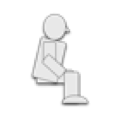Egophony
Introduction
Welcome to our website's egophony page. Here we provide a description of egophony and related voiced breath sounds along with clinical significance. We then compare healthy vs abnormal voiced sounds using audio recordings and text. Finally, we provide links to the lung sound training lessons available on this web site.
Our lesson can be found in this course. Secondly, our reference index is designed to provide quick access to stridor sounds, with audio tracks, listening guides and waveforms. Use this link for quick reference to heart and lung sounds.
What is egophony?
Voiced sounds, such as egophony, can provide important information about the presence of a lung abnormality and its location. The basic idea is that normal lungs (filled with air), do not readily transmit sounds, while consolidated lung tissue more readily transmits sounds. To use egophony during an exam, ask the patient to say 'e' as you auscultate over the chest wall. Over normal lung areas, you will hear the same 'e' tones. Over consolidated tissue, the 'e' sound changes to a nasal quality 'a' (aaaay), like a goat's bleating. The sound will often become louder over consolidated tissue. The next paragraph and recordings will make this clearer.
How to do egophony (Egophony Test)
While positioning the stethoscope's diaphragm on the chest wall, ask the patient to say “eee”. With normal lungs, an “eee” is be heard. If the lungs are consolidated, a nasal 'aaaay' (as in 'say' or a goat's bleating) will be heard. Repeat this process over the both sides of the chest. You should verify that the patient is correctly saying 'eee'.
Egophony: Healthy vs Abnormal
Listening Tips
Having asked the patient to say 'e' as you auscultate the lungs, you may hear two different sounds as presented below.
Egophony - Healthy
The sound is an 'e'.


The patient's position is sitting.
Egophony - Consolidated Lungs
Listen for 'a' (aaaay).


The patient's position is sitting.
Respiratory Sounds Reference Guide
Our auscultation reference guide provides quick access to this sound as well as many other adventitious sounds. Each sound is described also with an audio recording and waveform.Authors and Reviewers
Authored by Diane Wrigley, PAMedically reviewed by Dr. Barbara Erickson, PhD, RN, CCRN.
Special thanks to Dr. Raymond Murphy, MD, PhD.
Quick Links to Other Breath Sounds
While we have many breath sound lessons and quick references on this website. Please use the links below.
Bronchial Breath Sounds
Adventitious Breath Sounds
Adventitious Lung Sounds
Wheezing
Rhonchi
Fine and Coarse Crackles
Rales
Egophony
Auscultate
Auscultation Lung Sounds Audio
Related Lessons
Two lessons on egophony sounds are part of our Intermediate Lung Sounds course. There are also lessons on bronchophony and whispered pectoriloquy, which are other types of voiced sounds. We suggest taking the full course (about 20 minutes), but the egophony lesson can be used without the full course.
| Intermediate Lung Sounds
The goal of this intermediate course is to expand your observational skills when auscultating breath sounds. The course lessons include voiced sounds: bronchophony, egophony and whispered pectoriloquy. We also provide auscultation lessons on several types of wheezes, crackles and stridor. Each of these lung sound lessons includes audio, text and dynamic waveform. The anatomy pages use illustrations to reveal an example of each lung sound (anatomy not yet available on smartphones). |
| 1 | Vesicular - Diminished |
| 2 | Bronchophony - Healthy |
| 3 | Bronchophony - Abnormal |
| 4 | Egophony - e |
| 5 | Egophony - a |
| 6 | Whispered Pectoriloquy - Healthy |
| 7 | Whispered Pectoriloquy - Abnormal |
| 8 | Wheeze - Expiratory |
| 9 | Wheeze - Monophonic |
| 10 | Wheeze - Polyphonic |
| 11 | Crackles - Early Inspiratory (Rales) |
| 12 | Crackles - Late Inspiratory (Rales) |
| 13 | Stridor |
References
Sarkar M, Madabhavi I, Niranjan N, Dogra M. Auscultation of the respiratory system. Ann Thorac Med. 2015 Jul-Sep;10(3):158-68.Wipf JE, Lipsky BA, Hirschmann JV, Boyko EJ, Takasugi J, Peugeot RL, Davis CL. Diagnosing pneumonia by physical examination: relevant or relic? Arch Intern Med. 1999 May 24;159(10):1082-7.
Benbassat J, Baumal R. Narrative review: should teaching of the respiratory physical examination be restricted only to signs with proven reliability and validity? J Gen Intern Med. 2010 Aug;25(8):865-72.
Sapira JD. About egophony. Chest. 1995 Sep;108(3):865-7.
Taylor F. The Causation of Egophony. Med Chir Trans. 1895;78:127-49.
?
main Pv# 1 , InitialPages , pix False , #Drops 0 ;